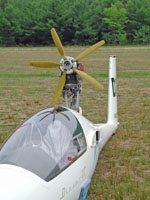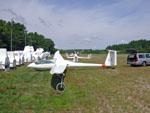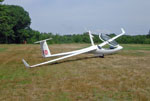Photo Page 6
 |
When the engine retracts, Frank Spital's Discus 2T "D2" looks and flies just like any other sailplane. Depending on engine power, the motor is either a "sustainer", intended only to help you get home when the lift dies, or a "self launcher", which also allows you to take off unassisted (launching, especially from grass, takes much more power). To the purists amongst us, an engine is just plain cheating. To the converts, the convenience of not needing a tow plane or of not having to "land out" when the lift dies, is just fine. Another type of motor-glider is an airplane and glider rolled into one, like the Grob 109. As you might expect, such a marriage works for some. For others, an aircraft that tries to be both an airplane and a glider, is not a very good airplane, nor a very good glider. |
 |
6N On Tow - January 7, 2007. Mike Pitoniak, tow pilot. Photo by Ritts Howard. |
 |
"Lima India" (LI) a Duo Discus owned by a 5 GBSC member partnership. This glider was featured in the movie A Fine Week Of Soaring by Juan Mandelbaum, a fellow club member. If you buy only one soaring video, this should be it, IMHO. |
 |
Dave Nadler's
Antares 20E.
The Antares is the worlds only production electric powered self launching sailplane.
Very large (and heavy) batteries in each wing root supply enough power for
a 10,000 foot climb. Since on a decent day a 2,000 foot climb (or less)
can connect you with a thermal, plenty of power remains for later when the
lift dies and you need to get home. After the motor is shut down, the
assembly folds backwards into the fuselage (the motor bay doors are easily
seen if you zoom in on the lower picture). When the glider is put away in it's trailer at the end of the day, the trailer is plugged into an AC outlet (either 120 or 240V) and the batteries are recharged over night. |